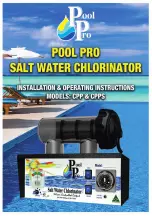
45
P/N S794 Rev. H 8-11-14
MAX-E-THERM
®
Pool and Spa Heater Installation and User’s Guide
Maintenance Instructions
CARE AND MAINTENANCE
WARNING
Risk of fire or explosion from flammable vapors.
Do not store gasoline, cleaning fluids, varnishes, paints, or other volatile
flammable liquids near heater or in the same room with heater.
The following maintenance is recommended every six months and at the start of every swimming season:
1. Inspect the jacket covers and venting system to make sure that there are no obstructions to the flow of ventilating air
or burner exhaust. Check that room air intakes are open and clear of obstructions.
2. Keep the area in and around the heater clear and free from combustible materials, gasoline and other flammable
vapors and corrosive liquids.
3. Test the operation of the pressure relief valve by lifting the valve lever, (if installed).
4. Test for proper operation of the water pressure switch. (See “WATER PRESSURE SWITCH” (page 34) for testing
instructions).
5. On enclosed installations with high-temperature Special Gas Vent systems, repeat the “Final Installation Check,”
page 27
. Check for evidence of joint leakage. Make sure that joints have not slipped partially or completely apart.
Check pipe and fittings for cracks or breaks. The combustion air blower is permanently lubricated, and does not
require periodic lubrication. The burner does not require maintenance or adjustment by the user. Call a qualified
service technician if you suspect that the burner may require maintenance.
PRESSURE RELIEF VALVE
(NOT FACTORY INSTALLED)
Some U.S. local codes may require installation of a pressure relief valve (PRV).
Purchase separately (P/N 460925) and install a 3/4" pressure relief valve
complying with the ANSI/ASME Boiler and Pressure Vessel Code, having a
capacity equal to the Btu/hr rating of the heater.
The relief pressure of the valve MUST NOT EXCEED 50 PSI. The reliefvalve
must be installed horizontality. To install the valve, use a 3/4" x 3-1/2” brass nipple
at the manifold and one brass elbow and nipple (supplied), asshown in Figure 37.
No valve is allowed to be placed between the manifoldadapter and the relief
valve.
To avoid water damage or scalding from operation of the relief valve, install a
drain pipe in the outlet of the pressure relief valve that will direct water discharging
from the valve to a safe place for disposal. Do not install any reducing couplings
or valves in the drain pipe. The drain pipe must be installed so as to allow
complete drainage from the valve and drain line.
The relief valve should be
tested at least once a year by lifting the valve lever.
WARNING
Explosion hazard.
Any heater installed with restrictive devices in the piping system downstream from the heater, (including
check valves, isolation valves, flow nozzles, or therapeutic pool valving), must have a relief valve installed as described above.
Section 5. Maintenance
Figure 37.
Install brass nipple and
elbow as shown,
for a Pressure Relief
Valve
Pressure Relief
Valve












































